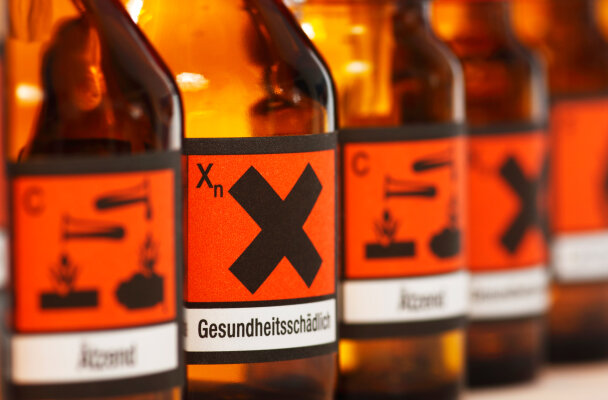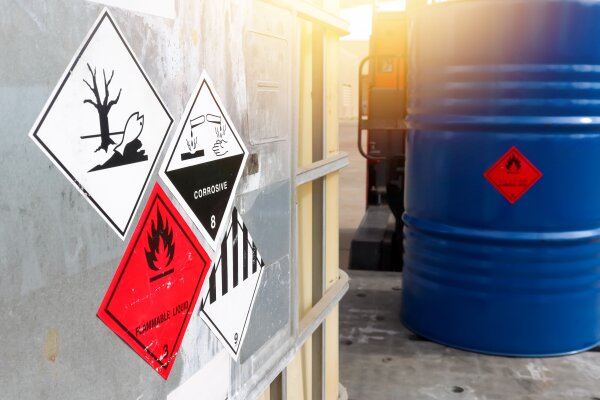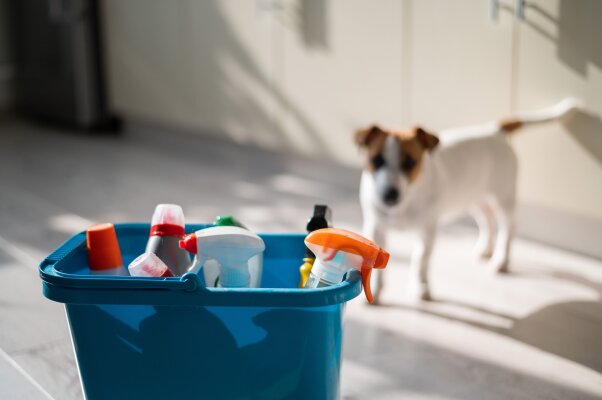Explosive substances: important information on dangerous goods class 1
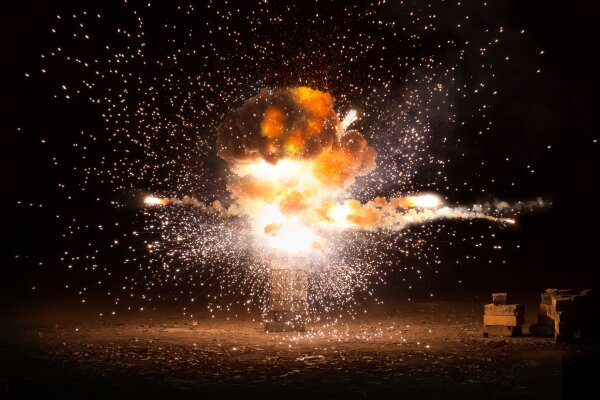
Handling explosive substances can quickly become dangerous – which is why these substances are subject to multiple legal regulations under the Explosives Act and ADR specifications indangerous goods class 1. In this blog post, we have briefly summarized the types of explosives, how their hazardousness is assessed, and what to look out for during storage, handling and transport.
Difference: explosive vs. explosive
To assess the explosion hazard of a substance, several properties must be considered. This results in two different definitions for substances of dangerous goods class 1 according to theExplosives Act (SprengG), CLP Regulation (EC) No. 1272/2008 and the Hazardous Substances Ordinance. Thus, the following distinction can be made:
- Explosive substances and mixtures: Explosive substances and mixtures are solid or liquid substances that exhibit a strong chemical reaction after activation. This produces gases that cause destruction in the environment due to high temperature, pressure or velocity.
- Explosive mixtures: On the other hand, there are so-called explosive mixtures which require an ignition source to become effective. They consist of flammable gases, vapors, mists, or swirled dusts and use air or other oxidizing agents. After activation, a sudden rise in temperature and pressure occurs due to self-actuated flame propagation.
Types of explosive substances
Not all explosives are the same – so different types can be differentiated from each other. Not only do they have different properties, but they are also not suitable for the same purposes. A further distinction can be made with regard to the size of the explosion.
Initial explosives and explosives
Initial explosives are those explosives that can be detonated by a small thermal or mechanical effect. In blasting caps, they are often used to initiate explosive charges. Common uses therefore include mines, grenades and other ammunition. Common representatives are fulminate mercury, lead azide and silver azide.
Explosives are defined as chemical substances or mixtures of chemical substances that can release a fairly large amount of energy in the form of a blast wave– i.e. a so-called detonation. Under certain conditions, they react very quickly, so that the velocity within the explosive is above the speed of sound. Typical explosives include dynamite, chlorate explosives, and black powder.
Pyrotechnic objects
Pyrotechnic articles or pyrotechnics are explosive mixtures of substances containing at least one fuel and one oxidizing agent. Therefore, it is also referred to as a pyrotechnic mixture. Their primary purpose is entertainment, as an effect is created from light, heat, smoke or fog. Pyrotechnic articles are divided into pyrotechnic sets depending on the hazard and intended use:
- Category F1 to F4: Fireworks
- Category T1 and T2: Pyrotechnic objects for stage and theater
- Category P1 and P2: Other pyrotechnic articles
Propellant
Propellants, on the other hand, are mixtures of propellant and oxidant that react very quickly with each other. The process is faster than “normal” combustion, but lower than that of explosives. They are popularly used as propulsionand ignited in enclosed or compressed spaces. Examples include black powder and smokeless gunpowder.
Ignition means
Finally, there are ignition devices, which in turn are used as aidsto trigger an explosion. They ensure that the necessary initial energy can be generated, which is required for the chemical reaction of an explosion. Typical representatives are, for example, matches and lighters.
Assessment of the explosion hazard of various substances
In order to be able to assess the explosion hazard of substances in dangerous goods class 1, various safety-related parameters are used. In particular, these include:
Detonation or burn rate
This is the speed in meters per second at which the explosion of the substance progresses. If this is only a few m/s, it is referred to as deflagration. High values of up to 10,000 m/s, on the other hand, are referred to as detonation.
Focal point
For liquid substances, the focal point can also be used. This describes the lowest temperature at which there is such a high vapor pressure that the resulting gas-air mixture can be ignited.
Flash point
If, on the other hand, the explosive substance is solid, the same property is called flash point.
Oxygen balance
The oxygen balance indicates whether too much or too little oxygen is available to completely oxidize the mixture of substances. If this value is 0, for example, the substance can be completely burned without leaving any oxidantbehind.
Explosive heat
The heat energy released during an explosion is called “explosion heat”.
Density
The density describes the ratio of the weight of the explosive to the volume of the explosion space. Low densities result inincreased detonation capability, but high densities produce more explosive power and explosiveness.
Normal gas volume
The “normal gas volume” is understood to be the total volume of gases produced during the complete reaction of the explosive substance. The value is determined under normal conditions.
Classification and labeling of explosive substances for transport and storage
Like all other substances in the dangerous goods classes, explosive substances must be labeled accordingly during storage and transport. This can ensure that optimum handling of the substances takes place and that the correct course of actioncan be taken in the event of any accidents. Classification and labeling can be carried out according to various criteria.
Explosive substances: subclasses
Explosive substances are assigned to dangerous goods class 1 according to the European Agreement concerning the International Carriage of Dangerous Goods by Road (ADR). In addition, there are six subclasses that form a further subdivision:
| Division | Description | Examples |
| 1.1 | substances or objects capable of mass explosion | e.g. explosives (types A, B, C and D), black powder and propellant powder |
| 1.2 | Substances with a risk of forming splinters, explosive fragments and thrown fragments that are not capable of mass explosion | e.g. fireworks, weapon cartridges and bombs (with explosive charge) |
| 1.3 | Substances or articles with a fire hazard which neither form splinters nor are capable of mass explosion | e.g. fluorescent powder and flash powder |
| 1.4 | Substances or articles without significant danger and with a low explosive effect, which are limited to the package. | e.g. cartridges and certain fireworks |
| 1.5 | Very insensitive materials capable of mass explosion | e.g. explosives (types B and E) |
| 1.6 | very insensitive non-mass-explosive materials | currently without practical significance |
Classification according to danger
Under chemicals law, there is another important label - namely the hazard statements, which are defined as so-called H-phrases. They are defined in accordance with CLP Regulation (EC) No. 1272/2008 and include the following classifications for explosive substances:
- H200: Instabil, explosive
- H201: Explosive, danger of mass explosion
- H202: Explosive, great danger due to splinters, explosive and thrown pieces
- H203: Explosive; danger by fire, air pressure or splinters, blasting and throwing fragments.
- H204: Danger due to fire or splinters, explosive and thrown objects
- H205: Fire mass explosion hazard
- H206: Danger from fire, blast or explosive; increased risk of explosion if desensitizer is reduced.
- H207: Danger from fire or explosive fragments; increased risk of explosion if desensitizer is reduced.
- H208: Danger from fire; increased risk of explosion if desensitizer is reduced.
- H230: May react explosively even in the absence of air.
- H231: May react explosively at elevated pressure and/or temperature, even in the absence of air.
- H240: Heating may cause explosion
- H241: Heating may cause fire or explosion
- H271: May cause fire or explosion; strong oxidizer.
- H280:Contains gas under pressure; may explode if heated
Labeling per GHS symbol and hazard number
Furthermore, according to theGHS (Globally Harmonised System), there is also a classification and labeling obligation for the placing of dangerous goods on the market. This hazardous substance labeling includes a hazard symbol and hazard number. Thus, according to international standards, it is recognizable at first glance what kind of hazards are involved. For explosive substances, a pictogram of an explosion and the code number 3 or 4 are used - depending on the aggregate state of the substance.
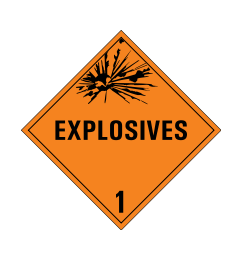
Classification into compatibility groups
In addition, there are also compatibility groups for dangerous goods class 1, which can be seen as a supplement to the subclasses. Unlike the previous classification, they do not have to be externally visible during transport, but allow the correct safety measures to be taken when handling the substances and during storage. The compatibility groups are indicated by a letter:
| Group | Description |
| A | Fuel |
| B | Item containing ignition material and having less than two effective safety features |
| C | Fuel or other deflagrating explosive substance |
| D | Detonating explosive substance or black powder |
| E | Article with detonating explosive substance that does not contain detonating means with propelling charge |
| F | Article with detonating explosive substance containing a means of initiation with a propelling charge or without a propelling charge |
| G | Pyrotechnic substance or article containing pyrotechnic substance |
| H | Object with explosive substance and with white phosphorus |
| J | Article with explosive substance and with flammable liquid or flammable gas |
| K | Object with explosive substance and with toxic chemical effect |
| L | Explosive substance or article containing explosive substance posing an increased risk, so that separation of each type is necessary |
| N | Items with predominantly extremely insensitive substances |
| S | Articles with such packaging that limits the effect of any unintended reaction on the package |
Regulations for the transport
The ARD regulations contain descriptions of which explosive substances - and with which classification, packaging and labeling - may be transported. In addition, however, there are also bans. For example, explosives that are particularly sensitive or where spontaneous reactions are possible may not be transported at all according to these specifications.
The same applies, incidentally, to explosive substances and articles whose classificationin a subclass is either unclear or impossible. If the items are of compatibility group K, transport of dangerous goods is also not permitted. In particular, the following subclasses are affected:
- Division 1.2:K UN number 0020
- Division 1.3:K UN number 0021
Packages
In order to be allowed to transport hazardous materials of dangerous goods class 1, they must comply with the specified packaging properties according to ADR Annex A (point 1). There, several prerequisites are described at once, which mainly include the following aspects:
- Carriage must be in a ready-for-shipment condition (i.e., pre-packaged) so that escape and/or increased risk from accidental ignition can be prevented (for example, due to changes in pressure, temperature, or humidity)
- The complete package must be suitable for safe use under normal conditions of carriage. This includes, for example, the possibility of predictable stacking.
- The transport must not lead to an increase in the risk of explosion.
- Packagings or intermediate bulk containers (IBC) of packing group II (i.e. with Y marking) must be used.
- Double protection against leakage must be provided for liquid explosives.
Legal regulations for explosive substances
Since explosives can pose a high risk, the ADR regulations are of course not the only legal requirements in this context. Both handling and use are governed by many other legal regulations and ordinances, which in Germany include in particular the Explosives Act (SprengG).
In addition to the definition of penalties and fines (for example, of 50,000 euros for violation of the ignition ban), there are other classifications. Pyrotechnic articles are divided into different groups:
- Class 1: Smallest fireworks (for example table fireworks and sparklers), which may be sold all year round.
- Class 2:Small fireworks (like firecrackers)
- Class 3:Medium fireworks (e.g. rockets)
- Class 4: Large fireworks (such as ball bombs and high altitude fireworks rockets).
- Class T: Fireworks from 18 years and those intended exclusively for pyrotechnicians.
FAQ
According to the chemical definition, explosives are those compounds or mixtures that consist in part of the oxygen element and can oxidize with enormous speed. Explosiveheat and gases are generated in the process. Common representatives include explosives, propellants and detonators.
Regulation (EU) 2019/1148 is considered a so-called precursor lawand establishes restrictions on the sale of substances from which explosives can be produced. These include, for example, hydrogen peroxide, nitric acid, nitromethane, sulfuric acid and sodium and potassium chlorate.
The Explosives Act (SprengG) deals with the handling, circulation and import of explosives and specifies corresponding goods in classes(1 to 4 and T). This includes small fireworks, small fireworks, medium fireworks and large fireworks as well as fireworks from 18.
Under Section 5f of the Explosives Act, "other explosive substances" are defined as those "used as auxiliary agents in the manufacture of chemical products" or as explosive substances used for "technical, scientific, analytical, medical and pharmaceutical purposes."
Do you have questions about the topic or would you like to suggest a topic? Please contact us by phone at +49 30 2096579 00 or send us an email at info@medsolut.com.

